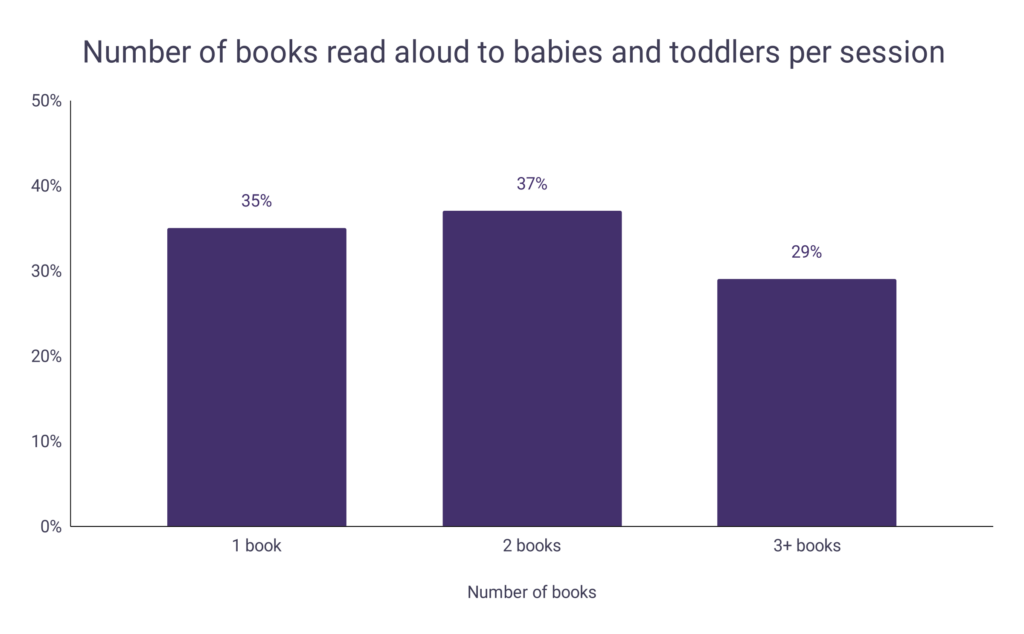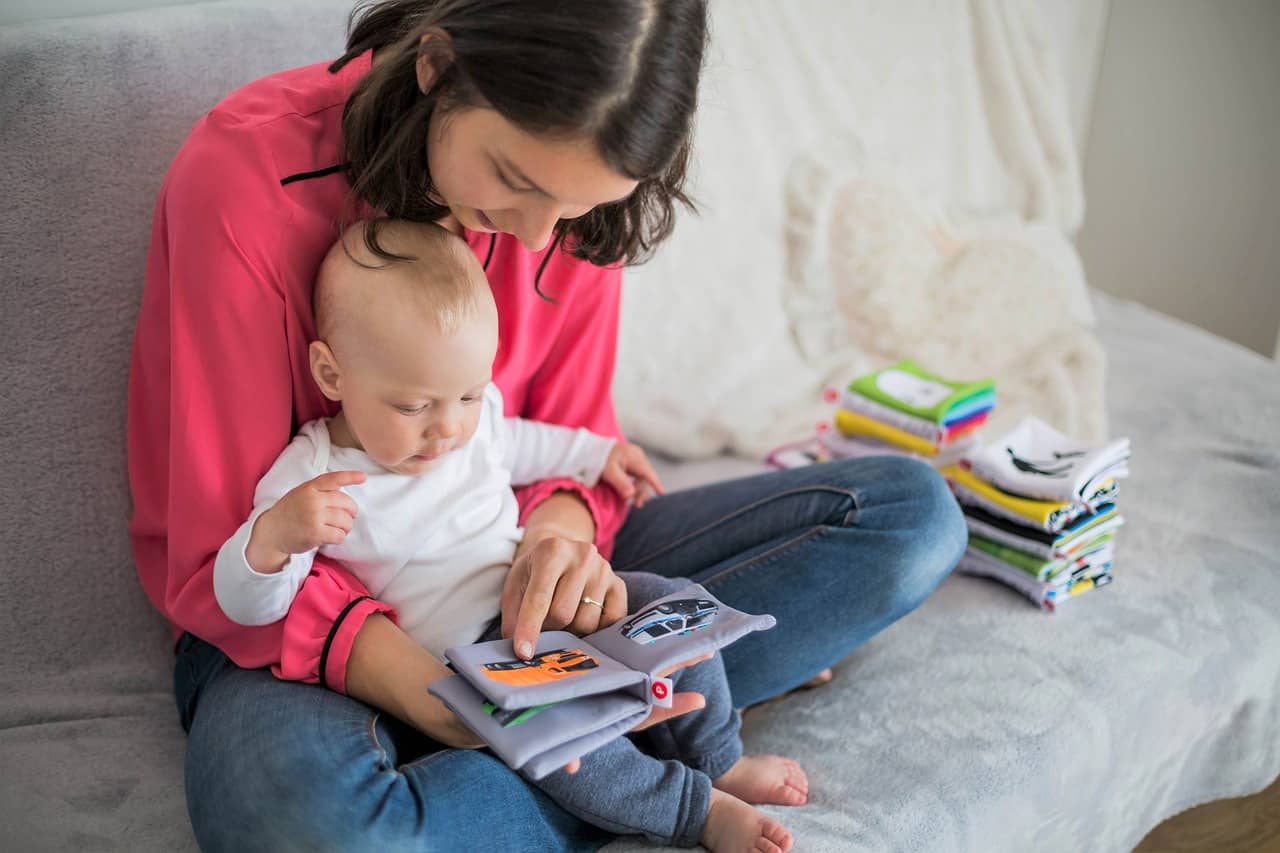Reading to babies provides many benefits, allowing them to understand different methods of communication and the world around them. By beginning the habit at a very early age, it can develop their listening, memory and vocabulary and even introduce them to numbers, colors and shapes.
- Reading one picture book to a baby every day will expose them to around 78,000 words annually.
- When compared to other kids of their age, children who were read to as newborns were found to have larger vocabularies and better mathematical abilities.
- Frequently reading to your baby allows them to speak more words by 2 years of age when compared to those not read to as often.
- Despite these positives, 55% of the 0 – 2 age group are still not read to on a daily basis.
- Although babies will not understand exactly what is being said, they are able to begin sensing different feelings through the tone, inflection and rhythm of a voice.
- After a while, they will start reacting and engaging with the story being read aloud.
- Even the experience of holding or touching books by itself can support cognitive development in babies.
- Reading aloud is the perfect way to create a strong emotional bond with a very young child, due to their love of hearing familiar voices.
- Parents are less stressed about their relationship with their children and witness reduced behavioral issues later down the line by engaging their babies in shared reading and play.
Percentage of babies, toddlers and children read to frequently
Although reading to babies, toddlers and children frequently has been seen to produce a significant number of benefits, the activity is still not as widespread as it could be.
- Research has shown that 45% of the 0 – 2 age group are read to frequently*.
- 58% of the 3 – 4 age group are read to frequently.
- 44% of the 5 – 7 age group are read to frequently.
- By focusing on increasing the percentage of babies and toddlers in the 0 – 2 age group that are read to frequently, it may be possible to increase the percentage of children read to frequently in older age groups.
*daily or nearly every day
| Age group | Percentage |
| 0 – 2 | 45% |
| 3 – 4 | 58% |
| 5 – 7 | 44% |
A graph is given below to show the percentage of babies, toddlers and children read to frequently by their age group:

How often do babies and toddlers choose what is read aloud to them?
Allowing babies and toddlers to choose what is read aloud to them can greatly influence their enjoyment of shared reading. When learners are allowed to gravitate towards the content they find most appealing, their interest can be heightened.
- A Canadian survey of parents shows that 23% of babies and toddlers* (aged 0 – 2) choose what book is read aloud to them every time.
- 40% of babies and toddlers aged 0 – 2 choose what book is read aloud to them most of the time.
- 19% of babies and toddlers aged 0 – 2 choose what book is read aloud to them some of the time.
- 19% of babies and toddlers aged 0 – 2 rarely or never choose what book is read aloud to them.
*who are read to at least one time per week
| Baby/toddler chooses | Percentage |
| Every time | 23% |
| Most of the time | 40% |
| Some of the time | 19% |
| Rarely/never | 19% |
A graph is given below to show how often babies/toddlers choose what is read aloud to them:

Number of books read aloud to babies and toddlers
In order to keep babies and toddlers interested in shared reading, it is important to introduce them to a number of different titles. Allowing them to choose from a range of books will mean they can show you when they are starting to lose interest in a title.
- A Canadian survey shows that 35% of parents who read aloud to their babies and toddlers (aged 0 – 2) at least once a week read just one book per session.
- 37% of parents who read aloud to their babies and toddlers at least once a week read two books per session.
- 29% of parents who read aloud to their babies and toddlers at least once a week read three or more books per session.
- Showing their development during read-aloud, babies will even make more word-like sounds when compared to other activities such as play.
| Number of books read per session | Percentage |
| 1 book | 35% |
| 2 books | 37% |
| 3+ books | 29% |
A graph is given below to show the number of books read aloud to babies and toddlers per session

Best book formats for babies
Different book formats can have a great impact on a child’s experience of learning. Throughout each early years stage, it is beneficial to make sure babies and toddlers have access to titles according to their age and level. Some organizations are even able to provide free books for babies, which is especially useful for parents with poor economic backgrounds.
- As newborns have limited levels of vision, black and white books can better help them comprehend what they are seeing.
- These can be made out of soft or hard materials and usually feature one large image on each page.
- Between 0 and 3 months, babies will begin to focus their eyes on simple page patterns.
- Once a baby reaches 6 months, books made of hard materials (board books) can be the best option, allowing them to interact and turn pages without causing damage.
- Picture books can introduce them to letters, colors and shapes which they will begin recognizing with increased exposure.
- In particular, it is best to select books that contain:
- Pictures of simple objects: For association with the world around them.
- Textured surfaces: To help with their sense of touch.
- Sounds: To help with their sense of hearing.
- Simple sentences: To allow babies to become used to the basics of the language.
- Repetition and rhymes: To encourage interest and overall learning.
- When comparing physical books to digital, young children find print books more engaging than e-books.
- This could be partly due to the increased interaction that occurs between parent and child when reading a print book.
- What’s more, digital devices can distract babies and young children when reading ebooks, which is detrimental to their engagement and concentration.
Benefits of reading to baby in womb
Reading to a baby prenatally can be a great way to initiate a feeling of secure attachment. Furthermore, doing so can even strengthen the bond between the parent(s) and child in later years.
- As babies are read to in the womb, they are provided additional opportunities to hear familiar voices.
- A baby’s fetal heart rate can lower from being read to in a relaxed manner, especially if the voice of the reader is the mother.
- The process of language learning is believed to begin in utero.
- Newborns are understood to prefer listening to the language that they were exposed to whilst in the womb.
- Possibly due to their time in the womb, the brains of babies have even been shown to distinguish their mother’s voice from a stranger from just the way the word “baby” is spoken.
- For those just born, one study of preterm infants in the neonatal intensive care unit showed that book reading had positive effects on both the infants and their parents alike.
When do you start reading to babies?
As a general rule, there are benefits to be gained from reading to a child as early as possible, so it is advisable to get a head start on a shared reading habit.
- Although recommendations vary, reading to babies as early as birth is very common.
- However, some people may even wish to read to their child whilst in the womb to develop an extra feeling of attachment.
- Starting the habit of shared reading too late can make it harder for babies, children or toddlers to adapt to a new experience.
- It is also important to make sure any shared reading is responsive, taking into consideration the desires of the child, and it should also be practiced as part of a regular routine.
How to read to babies
Although the benefits of reading to babies are well-known, its practice can be intuitive to some parents/carers but difficult for others. Understanding how to make the experience more effective may go a long way in increasing the uptake of shared reading for children in their earliest years.
The following list of tips can help to make shared reading more productive for babies and toddlers:
- Remove any distractions that may interrupt the session.
- Make sure the baby is comfortable, preventing their urge to fidget.
- Switch between reading the text and describing pictures as necessary.
- Repeat words/sentences and show items in real life, giving context.
- Allow the baby to lead the experience, learning at their own pace.
- Try to make it enjoyable by comforting, laughing and having fun.

